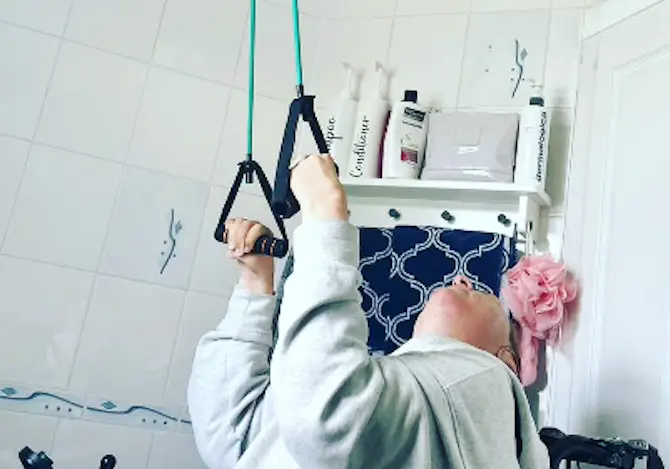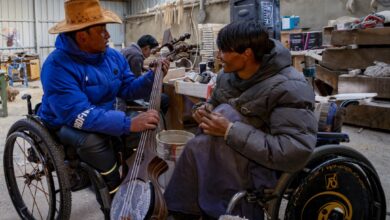5 Ways To Maintain Fitness In Winter

With a new year comes new goals and keeping fit is often one of them. Maintaining fitness is important for your health and wellbeing, but can come with challenges if you’re disabled, especially during the colder months. That’s why boccia player, Georgina Moore, has put together 5 ways to maintain your fitness in winter if you have a disability.
As a boccia athlete, I must keep as fit as I can all year round, which can be difficult during the colder and darker months. The motivation to go out to exercise is lacking and this is even more apparent now the cost of living is so high and Covid cases are rising once again.
Everyone needs to be as active as they can because it is proven that exercise boosts our physical and mental wellbeing.
Living with a severe physical disability my whole life has meant I have had to adapt my fitness regime to my capabilities. I am still feeling levels of Covid anxiety at the thought of going to the gym or swimming. I can also no longer afford the membership for these activities.
I am sure many of you are in the same position as me, so here are my top tips for maintaining your fitness levels at home. Please remember to seek advice from a professional to ensure these exercises are suitable for you.
1. Resistance bands
As an athlete with limited mobility, resistance bands or therabands have been fundamental in my fitness regime. They are relatively inexpensive and you can attach them to any fixed object around your home.
Those with handles are attached to my cupboard door, hoist frame and toilet grab rail. These are all solid structures that will not pull off (this is very important for your safety).
There are also bands that don’t have handles, which I tie to the back of my wheelchair or tuck under my foot. You could also ask someone else to hold onto it.
Once the band is secure, you can do gentle stretches, pulling on the band in different directions.
I also have variable strengths of bands, so some are much harder to pull than others. Always start with the easier bands and gradually build up to the harder ones. You can also use your legs, feet, neck or back to stretch.
There are some great YouTube videos, but I really like the ones from WheelPower, such as Ella’s Wheelchair Workout Video 6: Resistance Bands Mix Up. You can even apply for some resistance bands free from its website.
If you would like to invest in more sophisticated equipment, check out the Fusion Wheel – all-in-one portable wheelchair gym on the Disability Horizons Shop.

2. Weight training
There is a vast selection of weights to purchase for home use, ranging from dumbbells to kettlebells, to full-on weight-lifting benches.
The good thing about weights is the variety of sizes and formats to choose from to suit your ability. It is very useful if you want to gain strength or maintain it in a particular part of your body. This might be your legs or upper body.
I use a 2kg dumbbell and although I don’t have the ability to lift it very far, it is still helping with my muscle mass.
I also have velcro wrist weights, which aren’t very heavy, but they are great for strapping on in the day whilst undertaking everyday activities to give me some strengthening exercises. Alternatively, you could do stretches with them whilst attached to your wrists or your ankles.
You can purchase a pair of Stepforwarder ankle/wrist weights with various weight options on Amazon.
3. Cardiovascular exercise
Both my cardio and spinal surgeons advised me to try and do some form of cardiovascular exercise, even if it’s just for 10 minutes a day, to get the heart rate up.
This is so important for our overall health, but can be incredibly difficult to achieve if you have limited mobility. Personally, I use a hand bike, which I bought off Amazon about six years ago and it is still going strong. It can also be used with your feet and is free-standing, so you can adjust it to any position you need.
I aim to do at least 10 minutes a day, five days a week. You can start off low and gradually increase your time, frequency and/or resistance as you begin to find it easier.
I love setting myself challenges, such as riding two minutes slow, then sprinting for 30 seconds and then repeating. The digital version of the bike I have tells you lots of information, such as the distance and number of rotations you have done, so it is great fun trying to set personal targets.
Other cardiovascular exercises you can do at home to get your heart pumping could be walking, pushing your manual wheelchair, using a portable rowing machine or doing sit-down aerobics. Again, to make it fun you can set yourself targets and challenges.
If you own a games console with a fitness game, such as Wii Sports or Wii Fitness, this is also a way to get your heart rate up, but you don’t need to purchase one just for this as there are many other accessible ideas out there.

There are a couple of alternatives available on the Disability Horizons Shop to meet your own budget and needs including the pedal exerciser and the deluxe hand exerciser.
If you struggle to grip the handlebars you can use special equipment to help with this, such as Active Hands gripping aids.
4. Sit-down Pilates
There are many ways we can do gentle stretches, whether it’s sitting, lying down or standing up. Before lockdown, I used to do a sit-down Pilates class, which taught me so many different stretches that I could adapt to my disability.
I also bought a Pilates ball, which is a small inflatable ball that can assist with stretching. Plus, there’s a fantastic sit-down Pilates video my personal trainer sent me during lockdown, which was designed for people with multiple sclerosis (MS).
Pilates and yoga also tie in with deep breathing and mindfulness exercises. A Boccia UK physio gave me such an insightful session once on deep breathing techniques and how beneficial this is to our health. It’s completely free and can be done by anyone, anywhere!
I also really enjoy Wim Hof’s breathing exercise videos on YouTube, which are aimed at all different levels. I was skeptical at first, but it can really make you feel better.
5. Indoor sports
 Taking part in sports can be difficult during winter, particularly if you don’t have a garden or a big indoor space – that’s part of why I advocate for boccia. It is a fully inclusive Paralympic ball sport, where you can throw, kick or use a ramp to propel balls as close to the Jack as possible.
Taking part in sports can be difficult during winter, particularly if you don’t have a garden or a big indoor space – that’s part of why I advocate for boccia. It is a fully inclusive Paralympic ball sport, where you can throw, kick or use a ramp to propel balls as close to the Jack as possible.
The game is similar to bowls, but you must be seated to play and the balls are soft leather. You don’t need to dash out and buy a boccia ball set, you can use stuffed socks or any soft ball.
During lockdown, I designed lots of fun challenges people can do at home. You can view these videos on my boccia club’s Twitter page.
If you fancy venturing out to a local boccia club, you can check out Boccia England online. It is an indoor sport and is usually low-cost to join a club and is accessible to everyone!
Hopefully, this has given you some ideas to keep fit at home this winter. Whatever you decide to try, remember to start off slowly, gradually build it up and do seek medical advice first if you’re unsure.
By Georgina Moore
More on Disability Horizons…





